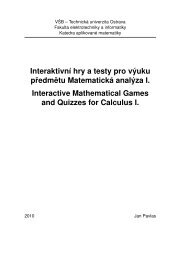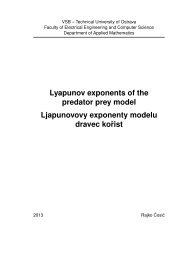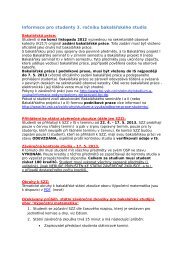The Boundary Element Method for the Helmholtz Equation ... - FEI VÅ B
The Boundary Element Method for the Helmholtz Equation ... - FEI VÅ B
The Boundary Element Method for the Helmholtz Equation ... - FEI VÅ B
Create successful ePaper yourself
Turn your PDF publications into a flip-book with our unique Google optimized e-Paper software.
2Contrary to stiffness matrices arising from <strong>the</strong> finite element discretization, matricesgenerated by <strong>the</strong> discretized integral operators are dense and <strong>the</strong> memory and computationalrequirements can be high. However, new fast boundary element methods have beendeveloped to reduce this drawback (<strong>for</strong> <strong>the</strong> ACA method see, e.g., [17]).Because <strong>the</strong> Laplace equation can be considered as a special case of <strong>the</strong> <strong>Helmholtz</strong>equation, this work is related to <strong>the</strong> bachelor <strong>the</strong>sis [19] and <strong>the</strong> paper [20] describing<strong>the</strong> boundary element method <strong>for</strong> <strong>the</strong> Laplace equation in 2D. This <strong>the</strong>sis is divided intoseveral sections, toge<strong>the</strong>r building a scheme <strong>for</strong> <strong>the</strong> application of <strong>the</strong> boundary elementmethod <strong>for</strong> solving <strong>the</strong> <strong>Helmholtz</strong> equation in 3D. In <strong>the</strong> first section we introduce functionspaces necessary <strong>for</strong> <strong>the</strong> boundary integral <strong>for</strong>mulation of <strong>the</strong> problem. In <strong>the</strong> followingpart we show <strong>the</strong> connection between <strong>the</strong> <strong>Helmholtz</strong> equation and <strong>the</strong> well-known waveequation and provide <strong>the</strong> representation <strong>for</strong>mulae <strong>for</strong> <strong>the</strong> solution. In <strong>the</strong> third section weintroduce boundary integral operators and describe <strong>the</strong>ir properties. Afterwards, we deriveboundary integral equations used <strong>for</strong> <strong>the</strong> computation of <strong>the</strong> missing Cauchy data. In <strong>the</strong>last part of this <strong>the</strong>sis we describe <strong>the</strong> discretization of <strong>the</strong> boundary integral equationsand provide some thoughts useful <strong>for</strong> practical implementation. Lastly, we provide somenumerical experiments.









